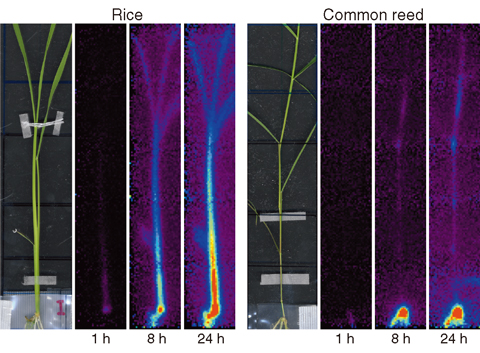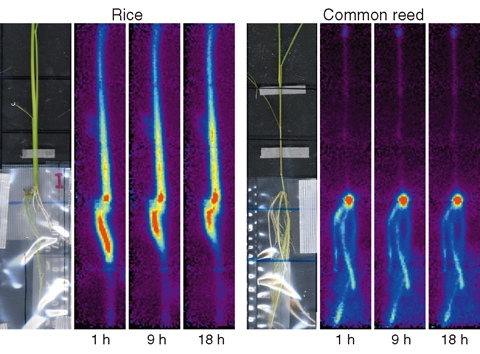
Fig.5-28 Sodium distribution after feeding 22Na into the nutrient solution

Fig.5-29 Sodium distribution after removing 22Na from the nutrient solution
Sodium is not an essential element for most plant species but is a toxic element. Therefore, the growth of rice is often inhibited in paddy fields that have suffered seawater by a tsunami or a typhoon. On the other hand, the common reed, which is classified to the same family as rice, has the ability to withstand a high sodium ion (Na+) concentration (i.e., it has a high salt tolerance), and therefore, it can grow in the wetlands of brackish water near river mouths, where freshwater and seawater mix.
A previous study of the mechanism behind salt tolerance in common reeds reported that the Na+ concentration in the fluid through the xylem is lower in the shoot than in the root. Since the xylem is the tissue that transports water and solutes including Na+ from the root to the shoot, this result suggests that the common reed has the ability to retrieve Na+ from the xylem in the region between the root and the shoot. However, there has been no direct evidence of this ability. Thus, in this study, we have tried to directly observe the Na+ movement in an intact common reed using a positron-emitting tracer imaging system (PETIS) that can noninvasively visualize the movement of various radioactive tracers.
Common reeds and rice plants were cultivated in a nutrient solution containing Na+ at a high concentration (approximately one-tenth that of seawater). After 22Na, a radioactive tracer of sodium, was fed into the solution, we observed the 22Na movement from the solution to the shoot for 24 h using PETIS. We found that 22Na was continuously transported to the upper shoot in the rice plants, whereas it was strongly accumulated in the shoot base but not transported to the upper shoot in common reed plants (Fig.5-28). Furthermore, we replaced the original solution with a fresh nutrient solution without 22Na and traced the 22Na movement inside the plants for 18 h. Using the serial PETIS images (Fig.5-29), we quantitatively analyzed time-course changes of 22Na in small consecutive compartments set along the plant axis. As a result, 22Na ions in the root of the rice plant moved continuously upward, but in contrast, those in the common reed moved downward to the root tip. These results indicate that the common reed has the ability to exclude Na+ downward from the shoot base and consequently maintains low Na+ concentration in its shoot.
In this study, we elucidated the common reed-specific mechanism of Na+ exclusion, and we are now exploring the genes involved in Na+ retrieval from the xylem and Na+ exclusion from the root. We expect to produce a salt-tolerant rice plant by introducing the genes of the common reed in the future.
This study was partially supported by the Tokyo University of Agriculture Grant-in-Aid for Advanced Study Projects and the Japan Society for the Promotion of Science (JSPS) KAKENHI Grants-in-Aid for Scientific Research (B) (No.18658028, 21380049).